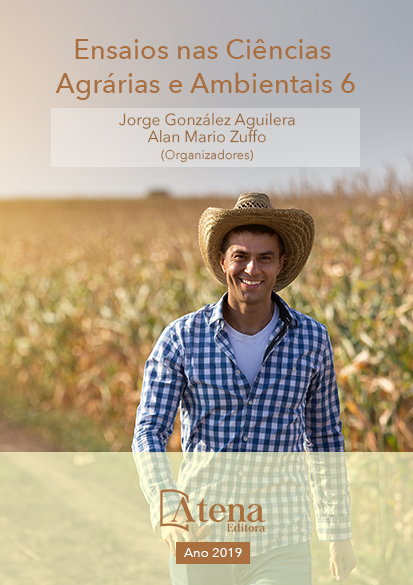
RENDIMENTO BIOLÓGICO E COMPONENTES MORFOLÓGICOS DE CULTIVARES DE SOJA COM DIFERENTES GRUPOS DE MATURAÇÃO SUBMETIDOS A DESFOLHA NOS ESTÁDIOS V6 E R3
Quanto menor o grupo de maturação
(GM) da cultivar menor é seu ciclo e sua
estrutura vegetativa, o que pode influenciar
na tolerância a desfolha. Este trabalho teve
como objetivo avaliar o rendimento biológico
e componentes morfológicos de cultivares
de soja com diferentes grupos de maturação
submetidas à desfolha nos estádios V6 e R3.
Foram conduzidos dois experimentos em casa
de vegetação no município de Lages – SC,
na safra 2016/2017. Foram avaliadas três
cultivares com GM distintos: Veloz RR com GM
5.0, NA 5909 RG, com GM 5.9 e TMG 7262 com
GM 6.2. Cada cultivar foi submetida a cinco
níveis de desfolha, equivalentes a 0%, 16,6%,
33,3%, 50% e 66,6% da área foliar. No primeiro
experimento as desfolhas foram impostas
no estádio V6 e no segundo no estádio R3.
Na desfolha em V6, o rendimento biológico
das cultivares Veloz e NA 5909 decresceu de
forma linear a medida que o nível de desfolha
aumentou. Na desfolha em R3, a cultivar NA
5909 apresentou decréscimo linear de seu
rendimento biológico em função do aumento
do nível de desfolha, enquanto as cultivares
Veloz e TMG 7262 apresentaram decréscimos
quadráticos. O comprimento da haste principal
e o número de nós na haste principal não
apresentou diferença em função dos diferentes
níveis de desfolha, tanto no experimento
em V6 quanto em R3. A desfolha influencia
negativamente o rendimento biológico da soja,
mas não altera a sua estatura e número de nós
na haste principal, tanto quando é efetuada em
V6 como em R3.
RENDIMENTO BIOLÓGICO E COMPONENTES MORFOLÓGICOS DE CULTIVARES DE SOJA COM DIFERENTES GRUPOS DE MATURAÇÃO SUBMETIDOS A DESFOLHA NOS ESTÁDIOS V6 E R3
-
DOI: 10.22533/at.ed.42119160118
-
Palavras-chave: Glycine max, Área foliar, Manejo de pragas.
-
Keywords: Glycine max, Leaf area, Pest management.
-
Abstract:
The lower the maturity group (GM) of the cultivar smaller is its cycle and
its vegetative structure, which may influence the defoliation tolerance. This work aimed
to evaluate the biological yield and morphological components of soybean cultivars
with different maturation groups submitted to defoliation in the V6 and R3 stages. Two
experiments were carried out under greenhouse conditions in the municipality of Lages
- SC, in the 2016/2017 harvest. Three cultivars with different GM were evaluated: Veloz
RR with GM 5.0, NA 5909 RG, GM 5.9 and GMG 7262 with GM 6.2. Each cultivar
was submitted to five levels of defoliation, equivalent to 0%, 16.6%, 33.3%, 50% and
66.6% of the leaf area. In the first experiment the defoliation was imposed in the V6
stage and in the second in the R3 stage. In V6 defoliation, the biological yield of the
cultivars Veloz and NA 5909 decreased linearly as the level of defoliation increased. In
the defoliation in R3, cultivar NA 5909 showed a linear decrease of its biological yield
due to the increase of the defoliation level, while the cultivars Veloz and TMG 7262
presented quadratic decreases. The length of the main stem and the number of nodes
in the main stem did not differ according to the different levels of defoliation, both in V6
and R3 experiments. Defoliation negatively influences the biological yield of soybean,
but does not alter its height and number of nodes in the main stem, both when carried
out in V6 and in R3.
-
Número de páginas: 15
- Murilo Miguel Durli


